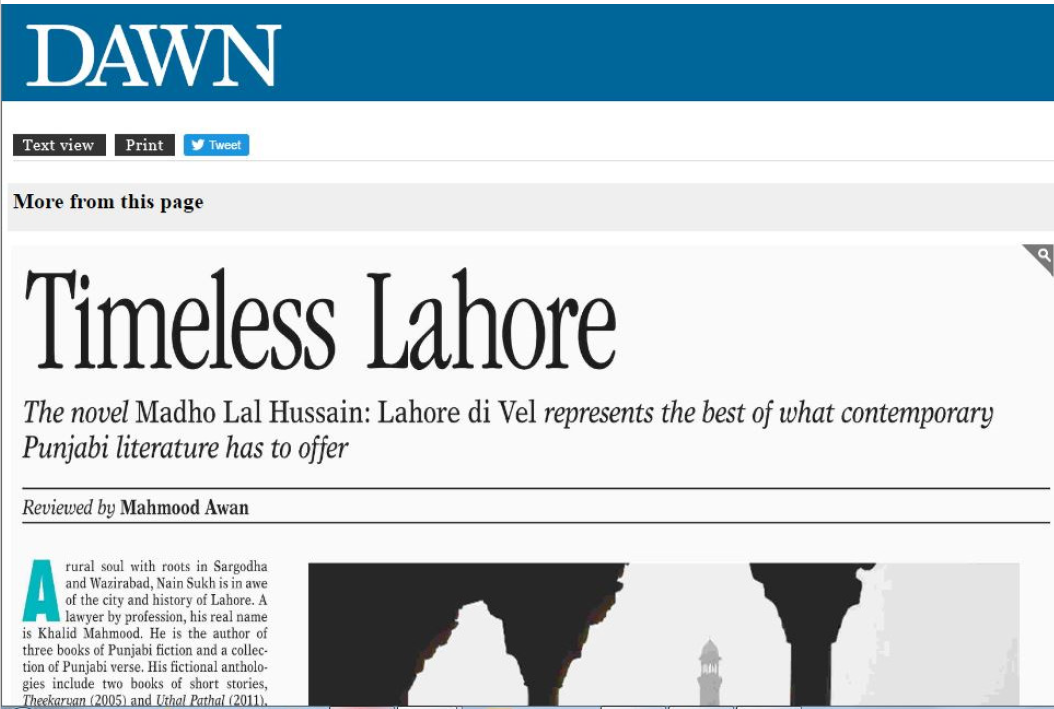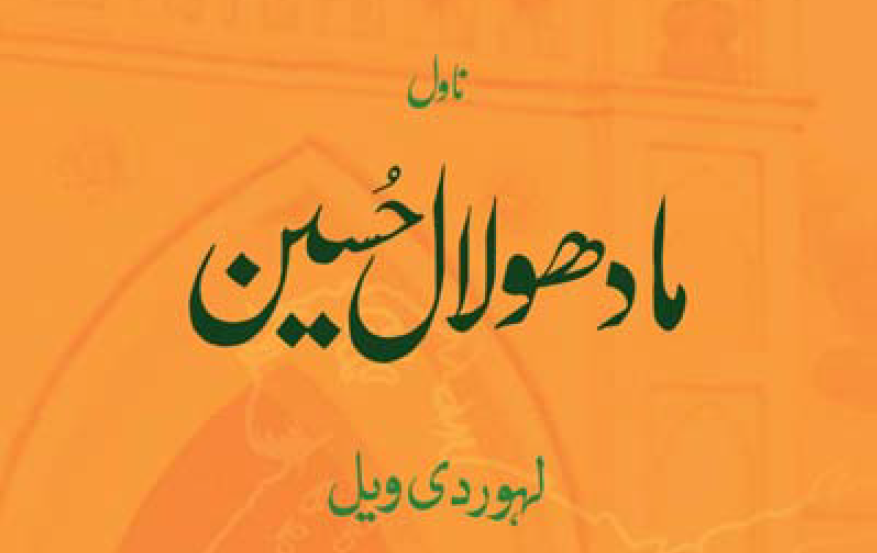A rural soul with roots in Sargodha and Wazirabad, Nain Sukh is in awe of the city and history of Lahore. A lawyer by profession, his real name is Khalid Mahmood. He is the author of three books of Punjabi fiction and a collection of Punjabi verse. His fictional anthologies include two books of short stories, Theekaryan (2005) and Uthal Pathal (2011), and a novel, Madho Lal Hussain: Lahore di Vel (2015). Kikkar tay Angoor (1994) is his anthology of poems.
Madho Lal Hussain: Lahore di Vel was recently judged as the best Pakistani Punjabi novel of the year by the Vancouver-based Dhahan International Punjabi Literature Prize jury. The novel is one of the most talked-about works among the Punjabi literati in recent months.
Nain Sukh started writing this story back in 1994; first intended as a short story, then as a book of oral history, finally after 20-odd years it came out in the form of a novel. He has spun his story around two main protagonists, Hussain (a painter) and Mehboob (an NGO employee), symbolically contemporising Shah Hussain and his beloved Hindu Brahmin disciple, Madho Lal. Around these two characters he narrates Lahore’s history, culture and politics over 25 chapters. He has covered almost every historic event, significant character and place linked with Lahore. The source material for his story is mostly oral narratives that he recorded over two decades from a diverse range of individuals, from the jogis to the thugs of the city. Further inspiration came from the 17th century book of Sufi thought, Haqiqat-ul-Fuqara, which details the life and times of Madho Lal Hussain, believed to be written some 63 years after the death of Shah Hussain.
The novel Madho Lal Hussain: Lahore di Vel represents the best of what contemporary Punjabi literature has to offer
Nain Sukh adopts a stream-of-consciousness technique to move in and out of the current timeline of his novel, which spans the years from 2005 to 2011, frequently moving back and forth through the historic period on a non-linear scale. The novel begins with the ban on basant in 2005 and culminates with the infamous Raymond Davis incident in 2011. However, the real charm of the story lies not in these six odd years but in the Lahore of the past. ‘Kanjar Khana’ and ‘Dada Ji di Diary’ are the most absorbing chapters of the book. Nain Sukh is one of the few Punjabi writers who didn’t come to Punjabi via Urdu. He has never written in any other language except his mother tongue. This makes his language and diction exceptionally natural and original with no signs of the lingual alienation we come across in so many writers who write in Punjabi these days.
Nain Sukh has composed an oral history of Lahore like never before; to give it a form and a structure that can withstand this combination of fact and fiction is in itself a great achievement. However, his novel generates many opposing ripples too. Despite what the traditionalists and purists might say about the compartmentalisation of literary forms and genres, it is a novel; nevertheless, it presents a challenging reading experience. I loved the stories within stories of Lahore, but repeated neglect of his main protagonists over entire chapters and their missing associations creates gaps that are too lengthy.
The central characters appear as misplaced figures, inorganically patched together to tell a wider story in an overcrowded writing space. This act of bringing characters into the story and taking them out with rapidity, as well as attempts to link all those unlinked tales abstractedly, creates the risk of taking readers away from the main plot. It prevents one from connecting with the characters on an emotional or personal level, eventually making readers alien to their emotions and even absence and presence of many of these characters and themes.
Another aspect of literature that I missed dearly was the art of writing silence. Apart from sections in the chapter ‘Dada Ji di Diary’, I did not encounter any silence throughout my reading of the novel. There is too much talk, too many people and places speaking at the same time — too many voices, loaded with descriptive details.
Bhisham Sahni, legendary Hindi novelist and playwright, while talking about Tamas, his epic novel on Partition, once explained his methodology as follows: “it is not essential that an incident be sketched out in exact detail for literature to be alive and believable. Instead, I’d say that sometimes an exact sketch of reality is not as powerful as one portrayed with the help of imagination … You can keep on reading, collecting facts and figures — the more you base your work on facts, with the help of facts and figures, the weaker it would become. Similarly, if a writer picks a historical person or period for his narrative: the less facts and figures he collects, the more are the chances of his work being powerful and believable. Up to a point the real facts and figures would be helpful, but beyond that they would become obstacles to the unfettered evolution of the work, to the extent that the facts and figures would so take over the writer’s mind that his imagination would be blocked, it would be so tangled in the grip of facts and figures that it would cease to have any role in the unfettered evolution of the work.”
This is exactly the case with Madho Lal Hussain: Lahore di Vel. In spite of the immense potential of its writer and the content, it fails to evolve beyond a certain point. Those who were able to create literary masterpieces out of their folklore, oral histories, native landscapes and socio-political events were the ones who trusted their imagination and craft. Juan Rulfo’s Pedro Páramo, Gabriel García Márquez’s One Hundred Years of Solitude and The General in His Labyrinth are some examples.
I feel that if Nain Sukh had decided to write this as a book of oral history, it may have saved him from the labour and pains of developing an artificial skeleton of a novel. He would have been much freer to write with ease, thus making the work more valuable and refreshing. He would have had the liberty to add many other Lahori tales, including the ones he had to edit to save the fictional composition in this case. Nevertheless, one has to conclude that for such a complicated and vast subject, this is Nain Sukh’s way of writing about a historic city and its people.
Notwithstanding the aforementioned reservations of style, this book of prose is a must-read. It reaffirms that, alongside Zubair Ahmad, Nain Sukh is the best talent Punjabi fiction currently has to offer.
Published in Dawn, Books & Authors, August 7th, 2016.
https://www.dawn.com/news/1275435/timeless-lahore
https://www.dawn.com/authors/3587/mahmood-awan


